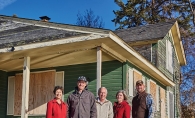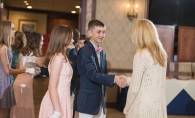Daily life has changed drastically over the last decade. “Back in the day,” we wrote letters and mailed them. We walked down the block and knocked on our neighbor’s door to chat. We picked up the phone and had a conversation to get the latest news. Now it’s instant everything online: conversation (called messaging), photographs (photo sites with strange names like Flickr and Snapfish) and news (on your “smart” phone). For those who remember when a computer filled an entire room—or even when TV was a novelty—it may seem like it’s not worth buying into the latest fad. But it’s good for our brains to learn new things, no matter what our age; it helps us understand what the grandkids are talking about and it can actually be fun. Below are some of the most popular ways to socialize over the Internet. Social networks Facebook, Twitter, Pinterest and LinkedIn are social networks—structures set up on the Web to connect people through common interests, relationships, job searches, etc. These online networks offer a way for people to make new friends or locate old ones, keep in touch, share news and learn from others. Each network has its own set of rules and guidelines. Designed to be user-friendly, most offer tutorials to walk a new user through the process. What about privacy? Users create a personal profile (basic information) that gives them access to each social network site. Then they decide what can be shared with whom, keeping information as private as desired. Requests are made to connect with the user which they can approve or deny. Privacy settings allow users to control their information. LEARN AND DO: Minnetonka Community Education offers Social Networking 101, a class that covers the basics. Facebook Launched in 2004, there are now more than 955 million users. After creating a personal profile, users request to be friends with others they know (or want to know), and accept or deny similar requests. Photos, videos and online chatting are a few ways people connect on Facebook. This social network allows users to locate long-lost friends or relatives, post information, opinions and ideas, and chat with others. LEARN AND DO: Hopkins Community Education offers Intro to Facebook, where you can learn the basics of this expansive social network. Twitter Users create short messages (up to 140 characters) called “tweets.” Established in 2006, there are now 400 million-plus users generating 340 million tweets every day. Tweets range from favorite quotes to simple messages to sharing website links. Users can tweet publicly (seen by registered and unregistered users) or directly to a specific person or group. Unregistered users can read tweets but cannot post them. LEARN AND DO: Joining an interest group can make learning much more fun. Minnetonka Community Education offers an ongoing group called Computer Special Interest Internet group. Learn alongside others who range from beginners to experts. Pinterest This network resembles a corkboard-style page (pinboard) where users “pin” images of things they’re interested in. Hobbies, events, recipes, crafts and more are “pinned” on a user’s page for others to see and comment on. It is especially popular among women to share information, ideas and photos on topics such as do-it-yourself (DIY) projects, crafts, food and drink, and clothing. Pinboards are organized by theme so pins can be categorized for easy viewing and sharing. Pinterest was launched in 2010 and was named one of the top 10 social networking sites in 2011 by Hitwise Data. LEARN AND DO: Hopkins Community Education offers Intro to Pinterest. LinkedIn Designed to connect professionals, users maintain lists of contacts, post resumes, search for jobs and post job openings. Connections allow users to review potential employers, seek introductions to other users through people they know, showcase work and find business opportunities. The “gated-access” requires an existing relationship (such as a colleague, friend, common relationship, etc.) which helps build trust among users. Launched in 2003, LinkedIn reported more than 175 million registered users in 2012. LEARN AND DO: Since LinkedIn is associated primarily with the professional side of networking, check out the Hopkins Community Education class, Social Networking for Business, for a different spin on social networking. Stacy Monson is the community relations director for Touching Hearts at Home, a non-medical in-home companion care agency in the west metro. She speaks and writes on topics such as healthy living, life older than 50 and the issues of aging and dementia.
Menu
From the December 2012 issue
Lake Minnetonka Senior Social Media Classes
Those who grew up without computers can get up-to-speed on social media thanks to a few lake-area classes.









